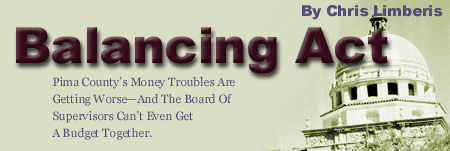
PIMA COUNTY IS stumbling toward the end of the 1998-99
fiscal year weighted down under a $49 million debt. And that's
the good news. County Administrator Chuck Huckelberry is preparing
to recommend a new budget of around $800 million, a 7 percent
increase over the current budget, that he hopes will include enough
new revenue through higher property taxes or--still a long shot--a half-cent sales tax.
 Huckelberry is essentially going it alone. The Board of Supervisors,
except for a few attempts by Republican Ray Carroll, has shown
little interest in the county's fiscal crisis. The Board has consistently
put off decisions on the current overspending, refused to cut
largesse to pet non-profit agencies and pet projects, and, in
clear testimony to its insouciance, has delayed hearings on Huckelberry's
new budget proposal until next month--the latest start in memory.
Huckelberry is essentially going it alone. The Board of Supervisors,
except for a few attempts by Republican Ray Carroll, has shown
little interest in the county's fiscal crisis. The Board has consistently
put off decisions on the current overspending, refused to cut
largesse to pet non-profit agencies and pet projects, and, in
clear testimony to its insouciance, has delayed hearings on Huckelberry's
new budget proposal until next month--the latest start in memory.
In addition to the continuing costs that have stretched the county's
bank accounts past their limits, the county will have to come
up with $21 million a year to operate and maintain the new juvenile
detention center and new jail.
Sheriff Clarence Dupnik, a Democrat in office since 1980, says
he will need another $14.5 million for equipment, including cars,
computers and radio communication systems, in the next couple
of years. Another $8.9 million will be needed for additional personnel--including
about $5.3 million for new deputies.
In addition, Kino Community Hospital continues to drain the healthcare
budget. Even if Kino can reverse its spiral, perhaps with the
help of new patients if the state lifts the freeze on the county's
HMO and allows it to enroll new indigent patients, Kino still
owes about $40 million to the county general fund and to a pooled
account that includes restricted school and fire district dollars.
It's not as if the county was forced into austerity. Through
the 1990s Pima County taxpayers have given their Boards of Supervisors
record amounts of cash and permission to borrow a record amount
of more money.
Pima County's levy--the amount that could be taken from taxpayers--rose
from $164 million for the 1990-91 fiscal year to $194 million
for the 1998-99 fiscal year. That 18 percent jump in the amount
that could be collected came despite a 6 percent drop in the overall
tax rate that meant, in gross terms, a roughly $30 cut in the
tax bill for the owner of a $100,000 home. But even as the tax
rate dropped, property values climbed, so few if any property
owners saw any savings.
Local property taxes account for less than a quarter of the county's
budget, but nearly half of the general fund budget. Other revenues
come from the county's share of state sales taxes and auto licenses,
federal and state healthcare programs, grants, development and
other fees, and fines.
Spending by the county through the decade, including consecutive
dips in the first three years, has risen 35 percent from $594
million to the anticipated $800 million for the 1999-2000 fiscal
year that begins July 1.
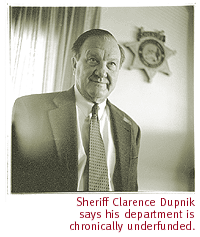 Voters had enough confidence in 1997 to give the county permission
to borrow even more--$712 million--for a long list of improvement
and construction projects that will be repaid by property taxes,
gas taxes and sewer fees.
Voters had enough confidence in 1997 to give the county permission
to borrow even more--$712 million--for a long list of improvement
and construction projects that will be repaid by property taxes,
gas taxes and sewer fees.
And the county has had more people to get the job done. Twenty
percent more, in fact, from 6,354 employees in 1990 to 7,648 now.
Budgets show more money from more people. But more importantly,
they show more money for more people. Between 1990 and
mid-1998 the county's population rose 24 percent, from 666,880
to 823,900.
In unincorporated Pima County, population jumped 26 percent,
from 247,540 to 311,310. With that many people, unincorporated
Pima County would be the fourth largest city in the state.
Counties, always extensions of state government, were never designed
to provide urban-level services.
It is particularly troubling not only because of the burden cities
can take off all county residents by providing much of their own
services, but because state revenue schemes greatly favor cities.
In addition to having their own authority to levy taxes and fees,
cities receive $190 a year in state revenue for every one of their
residents. With 250,000 people--an estimate that easily leaves
out anti-incorporation forces in Green Valley--put in cities or
towns, another $47.5 million in shared revenue would be distributed
annually in Pima County.
In 1990, the county issued 1,191 permits for new homes. Through
the end of this year, the 10-year figure is estimated to reach
22,163. Countywide, for all residential construction including
single-family homes, townhomes, apartment complexes and mobile
homes, the total from 1990 through 1998 is 71,771.
AS A RESULT of this frenzied growth, the Board of Supervisors
is now facing a host of social and financial problems.
Take a look at the criminal justice stats. As Sheriff Clarence
Dupnik will tell you, more people means more crime. And Tucson's
crime rate has soared, with 7,914 incidents of crime per 100,000
people--higher than those of New York, Washington, D.C., Philadelphia,
Los Angeles, Dallas, Detroit and Phoenix, according to the Uniform
Crime Report.
The number of calls to the Sheriff's Department for service has
jumped 67 percent in the '90s. The number of arrests has tripled
and is expected to reach 22,216 this year. The sheriff's patrol
divisions are chronically understaffed at 1.27 officers per 1,000
population. (The national average is 2.2 per 1,000.) And the jail
inmate population has climbed 60 percent. The jail, expanded under
pressure of a federal court order and opened in 1987, is now at
more than double its 731-person capacity.
 More cops and more arrests create more criminal cases: in 1993,
Superior Court judges on the criminal bench averaged 343 new cases,
adjudicated 350 cases and had a backlog of 279 cases. That rose
last year to an average of 427 new filings, adjudication of 420
cases and a backlog of 392 cases, according to Presiding Judge
Gordon T. Alley. Of that, there has been a 62 percent increase
in assault cases, a 27 percent increase in homicides, a 20 percent
increase in drug cases and an 11 percent increase in DUIs.
More cops and more arrests create more criminal cases: in 1993,
Superior Court judges on the criminal bench averaged 343 new cases,
adjudicated 350 cases and had a backlog of 279 cases. That rose
last year to an average of 427 new filings, adjudication of 420
cases and a backlog of 392 cases, according to Presiding Judge
Gordon T. Alley. Of that, there has been a 62 percent increase
in assault cases, a 27 percent increase in homicides, a 20 percent
increase in drug cases and an 11 percent increase in DUIs.
With more court cases, the county needs more money for indigent
defendants. Spending, at $15 million this year, is difficult to
control and dependent on the cases prosecutors take to trial.
Indigent defense is more than $2 million over its budget, largely
due to bills from appointed counsel.
Pima County prosecutors keep the system bursting. Thirteen criminal
judges in Pima County presided over 608 trials (or nearly 47 per
judge) two years ago. Compare that to Maricopa County, where 21
criminal judges heard 721 trials (or 35 per judge). Pima County
judges heard roughly 34 percent more criminal cases than their
Maricopa colleagues. Long a concern of county officials, the trial-rate
issue is dismissed by Democratic County Attorney Barbara LaWall,
just as it was by her Democratic predecessor and mentor Stephen
D. Neely. Says LaWall: "I wasn't elected county plea bargainer."
In all, taxpayers in the last 10 years have increased their annual
payments for the county's entire law enforcement and justice system
from $75 million to $129 million--a 71 percent increase.
And those are just law-and-order costs. Other budget busters
include:
• Wild, uncontained costs at Kino Community Hospital and
the overarching county health system have created a debt bumping
up against $50 million. Kino, a small hospital by Tucson standards,
is buried under $40 million in debt. And the health system lost
$14 million in the last 12 months under the direction of Dr. Richard
Carmona, a former Tucson Medical Center trauma surgeon who earlier
chaired the county commission that recommended against spinning
off Kino and the health system.
• There are lingering effects of property tax cuts ordered
by the Republican majority--Ed Moore, Mike Boyd and Paul Marsh--that
controlled the Board of Supervisors from 1993 through 1996. Only
Boyd, from central and foothills District 1, won re-election in
1996. (And he's trying to land a spot on the Arizona Corporation
Commission.) The maximum cut for the owner of a $100,000 house
was $52 (or $1 a week). Because of the breaks state law gives
homeowners, those in the high-tax Tucson Unified School District
saved pennies--or nothing--in some years, with the balance made
up by the state. However, the county could have earned $77 million
in the last five years had the tax rate stayed at the 1992-93
level of $5.64 per $100 of assessed value, according to an analysis
released earlier this year by the county administrator.
• As a result of those Republican tax cuts, the county's
reserve fund is dwindling. The reserve fund balance should be
5 percent of the general fund spending, or roughly $10 million.
The drop resulted in the county's general obligation bonds being
downgraded last year by Moody's Investor Service, which has cost
taxpayers through slightly higher interest rates.
• The Stadium District remains mired in debt. The district
includes Tucson Electric Park, practice fields and clubhouses
that serve the major league spring training home of Chicago White
Sox and Arizona Diamondbacks, as well as being home to the Diamondback's
AAA affiliate, the Tucson Sidewinders. It had a $5.9 million deficit
at the close of the last fiscal year, according to a report by
the state Auditor General's Office. Construction costs reached
$38 million, up $3 million from the county's projection and about
$13 million more than what local promoters estimated the complex
would cost in 1995. Huckelberry has taken steps to resolve most
of this debt through application of capital funds and restructuring
of the complex's debt.
• Operating deficits and debt continue at the Rillito Race
Track, a once-prominent quarter horse track south of the Rillito
River on North First Avenue. The overall debt ranges from $500,000
to $1 million. Threatened with closure in the early 1980s, the
race track was one of Moore's populist springboards to office
in 1984, the same year voters approved a measure that said the
track must be used for horse racing for 25 years. The referendum
remains in dispute and a county legal opinion says it can be overturned
by the Board of Supervisors. Some county officials would like
to sell Rillito's prime 80-plus acres for $9 million.
• The county's Engineering and Geographic Information System,
which got its start with a successful bond vote in 1986, has a
nearly $2 million debt.
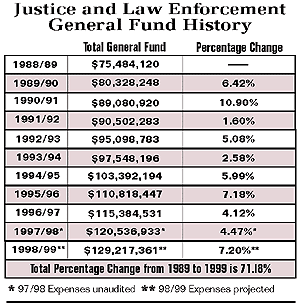 • The county-supported Southwest Fair Commission, which
operates the county fairgrounds southeast of Tucson, has a half-million
dollar debt. Pushed by Moore and Boyd, the Board of Supervisors
surprisingly granted the Fair Commission, whose members are appointed
by the supervisors, an interest-free $500,000 loan for development
of a motor-sports park. Much like the pitch from baseball promoters,
this venture was billed as one that would pay for itself. The
loan came directly out of the county general fund--the same property
tax-supported fund that has been too low to beef up thin sheriff
patrols. So far only $25,000 has been repaid. The agreement called
for annual $50,000 payments.
• The county-supported Southwest Fair Commission, which
operates the county fairgrounds southeast of Tucson, has a half-million
dollar debt. Pushed by Moore and Boyd, the Board of Supervisors
surprisingly granted the Fair Commission, whose members are appointed
by the supervisors, an interest-free $500,000 loan for development
of a motor-sports park. Much like the pitch from baseball promoters,
this venture was billed as one that would pay for itself. The
loan came directly out of the county general fund--the same property
tax-supported fund that has been too low to beef up thin sheriff
patrols. So far only $25,000 has been repaid. The agreement called
for annual $50,000 payments.
IN THE FACE of this partial list, the Board of Supervisors
has been stunningly detached. Four of its members, Democrats Sharon
Bronson, Dan Eckstrom and Raul Grijalva, and Republican Mike Boyd,
hoped to enact the first sales tax in county history, which would
have raised around $48 million in its first year. But Republican
Ray Carroll refused to go along with the plan, which required
a unanimous vote of the Board.
Aside from nodding to freezes that come even in the county's
flush years, the Board has done virtually nothing to curtail,
rearrange or fix spending. And supervisors have not formally taken
action to approve the operating debt taxpayers will be forced
to repay.
Grijalva, in his third term, contributed by ordering Huckelberry
to prepare three budgets: one with a sales tax, one with a property
tax increase and one without any tax increase.
With the sales tax dead, property taxes may have to be increased
by anywhere from
80 cents per $100 to more than $1 per $100. Homeowners outside
TUSD and a few other school districts will see the full effect--at
least $80 a year.
Still, supervisors have the latest start in memory to get to
work on the budget. Partly to accommodate vacation schedules of
Grijalva and Carroll, supervisors won't even sit down to begin
hearings until July 6--five days after the start of the fiscal
year. Given the county's fiscal condition, which Huckelberry has
described as a "crisis," hearings were to begin in May
with tentative adoption--setting a spending limit--coming in June.
By state law, the final budget must be set no later than the second
Monday in August.
Based on their performances in recent years, supervisors
are unlikely to get into the details. In the 1980s, in contrast,
supervisors would follow line items and vote on department budgets
as they were presented in hearings with the understanding that
changes could be made before or during final adoption. In 1989,
for example, Eckstrom won approval to cut an advertising budget
of about $200,000 from Kino Hospital's budget because he and others
had grown weary of seeing the hospital's administrator at the
time, Art Gonzalez, in every newspaper and television ad.
KINO WILL AGAIN be in the spotlight, whenever it shines,
but not over minor line items. Indeed, the lack of budget proposals
from Kino and the health system is the cause for the delay in
the total county budget proposal that is expected to be released
sometime this week.
Besides the $56-million-a-year Kino Hospital, the health system
includes the county's struggling HMO, the Pima Health Plan (down
from a high of 15,000 patients to 5,000), the Posada del Sol nursing
home and home-health services in a total budget that is around
$200 million, or a fourth of the projected county budget.
The hold-up is the result of the nearly two-year-old decision
by the Board of Supervisors to make management further diffuse
and have the health system administration report to an appointed
commission. That has been complicated by negotiations that have
degenerated into petty political squabbles.
Kino and the rest of Carmona's system have been spun off from
their former direct line under the Board of Supervisors, although
they remain firm liabilities of Pima County. In response to the
years of threats by Moore, Grijalva won approval to ostensibly
insulate Kino from political interference in 1997. Although supervisors
retain ultimate financial control, they ceded oversight to the
offshoot of the commission Carmona once chaired. It is led by
Grijalva's longtime friend and political ally Sylvia Campoy, head
of the City of Tucson Affirmative Action and Equal Opportunity
Office and, like Grijalva, a former member of the Tucson Unified
School District Board.
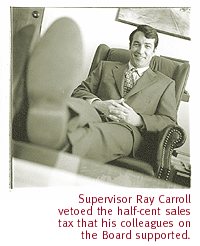 Grijalva got support for the move from Boyd and Carroll, the
Republicans who have been strong Carmona supporters. Eckstrom
and Bronson voted against that delegation of power.
Grijalva got support for the move from Boyd and Carroll, the
Republicans who have been strong Carmona supporters. Eckstrom
and Bronson voted against that delegation of power.
While Carmona once enjoyed Campoy's strong defense during confrontations
with the supervisors, the honeymoon is over. Carmona and Campoy
have clashed in meetings, and Campoy and a majority of the commission
have complained about Carmona's peripatetic schedule.
The infighting escalated over disclosures of accusations of a
time-card kickback scheme involving Kino employees and an investigation
of a popular Kino doctor, Charles Blanck, for questions about
prescriptions. Blanck had already turned himself into the state
Board of Medical Examiners for alcohol abuse.
Campoy has refused to forward Carmona's recommended budgets,
saying they are incomplete. Differences came to a head during
the commission's June 7 meeting, when Carmona appeared to be waving
sheets of paper at Campoy.
Carmona has blamed Campoy and has not been shy about telling
her what she should do. In a May 21 memo, he said he was "extremely
concerned that the budgets that we have submitted to the commission,
in a timely fashion, have not been acted upon by you. Recent press
reports as well as assertions by some elected and appointed officials
have improperly stated that no budget has been forthcoming. In
fact, the budgets have been submitted.... I would suggest that
this is an issue of the highest priority."
Campoy was not amused.
In her page-long response, she accused Carmona of making "improper
and misleading" claims.
On the budget submittals and review, she told Carmona, "You
seem to be deflecting your responsibility.... Moreover, your spin
on this matter indicates that you believe that, somehow, I am
accountable for the budget situation relative to the problems
you have noted. Please cease your efforts along these lines.
"As chairperson of the commission, I am offended by your
behavior and simply don't have the time or tolerance to continue
dealing with your most recent flurry of memoranda that seem to
consistently suggest that I need to account to you or which attempt
to quickly divorce your responsibility in various matters."
Carroll, who once visited Carmona last summer at the doctor's
home on Coronado Island and says he "trusts" Carmona,
entered the fray when he took offense at one of Campoy's comments
at the commission's June 7 meeting.
"It's selective response," Campoy told Carmona. "If
Ray Carroll asks for something, in a heartbeat, staff is not too
busy to respond. If Sharon Bronson or Sylvia Campoy ask for something,
you don't have the time."
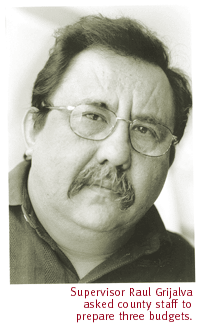 Carroll took the time to demand a "written and public apology
to me and all of the other participants of the June 7 meeting....
I have no intention of accepting your unfounded and unprincipled
accusations against me or Pima County staff."
Carroll took the time to demand a "written and public apology
to me and all of the other participants of the June 7 meeting....
I have no intention of accepting your unfounded and unprincipled
accusations against me or Pima County staff."
Whether the players will be able to move off this skirmish won't
be known until some form of budget hearings begin next month.
Like many public hospitals across the country, Kino has had money
problems for much of its 22-year history. Despite the operating
deficits and longterm debt, Kino's bills get paid, but only with
help from other county funds. Much of Kino's chronic problem is
the inability--through mistakes and improper management and training--to
collect from payers, either health plans or the federal government.
Recent studies have shown that Kino officials consistently fail
to file timely claims and that the claims have been fouled by
improper medical codes that, in some cases, have not been updated
in 10 years.
The key study begun last year by national management consulting
firm Arthur Andersen said "the decrease in the ability to
collect on receivables has led to a 57 percent increase in debt
to the county in 20 months to a current level of $35.5 million."
The same problem was discovered, for a lot less than Arthur Andersen's
$140,000 contract, by investigator Bill Heuisler in early 1985.
A political figure with close ties then to Moore, Heuisler's discovery
of boxes of Kino bills never sent was too sensitive for some county
officials, and his work was terminated.
Uncompensated care at Kino two years ago amounted to $5.6 million
of the $60 million in gross patient revenues, or 9.3 percent--the
highest of all hospitals in Tucson, according to county reports.
Huckelberry says he wants to pay off Kino's and the health system's
debt with three annual payments of $15.4 million. The money would
come either from the sales tax or property tax increase.
If he fails to gain support for the increased taxes, Huckelberry
wants to use the portions of the health system that are projected
to have cash balances at the end of the year. The county's units
with state indigent care contracts will have a combined $24.7
million in cash reserves at the close of the fiscal year at the
end of June.
The county's HMO is one of the health plans under contract by
the state's indigent care plan and Medicare alternative, the Arizona
Health Care Cost Containment System. Nursing home patients managed
by the county at Posada del Sol and through contracts with nursing
homes around the county are under the Arizona Long Term Care System
(ALTCS).
Carmona, critics complain, has deliberately driven up the balances
by refusing to allow those programs to pay Kino for services at
the hospital. He is resisting the transfer.
In a June 3 memo to Huckelberry, Carmona said: "Although
a seemingly simple solution, as you know, this approach has many
potential pitfalls including, but not limited to, the potential
threat to the financial viability of our plan at a time when we
are preparing for the ALTCS bid process and the fact that although
we are an integrated system, ALTCS is not concerned with Kino
or the Health System's debt and therefore is unlikely to support
such a transfer of funds."
The Pima Health Plan, for the first time, was restricted by state
officials during the last round of bids in 1997. The county HMO
was not allowed to accept any new patients. That cap may be lifted.
But for Kino, it may already be too late.
The Borrowers
The County's Money Problems Have A Lot Of People Pointing
Fingers.
PIMA COUNTY SUPERVISOR Mike Boyd was in a comfortable setting.
A former television talking head now in his seventh year in the
District 1 seat, Boyd was on the set on KUAT-TV's weekly reporters
roundtable on May 21, fielding questions about the county's budget
crisis.
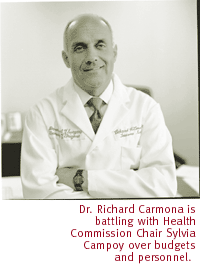 Asked about Pima County's practice of tapping school districts'
money to keep Kino Community Hospital afloat, Boyd admitted the
maneuver was a mistake.
Asked about Pima County's practice of tapping school districts'
money to keep Kino Community Hospital afloat, Boyd admitted the
maneuver was a mistake.
"We're going to have to pay interest on it," Boyd said,
his tone a mix of apology and surety. "We're not doing it
anymore."
But a couple of weeks later, Carol Bonchalk, the county's director
of financial and information services, said at a meeting of the
Pima Association of Taxpayers that the county was still using
commingled funds.
Aside from Boyd's lack of awareness, the quiet borrowing by Pima
County to cover portions of Kino's now $40 million debt has spawned
mystery and a blame game that could develop only in the sprawling
operation that is county government. The mystery is further cloaked
in the arcane laws of government finance and government accounting
principles that must somehow catalog activities in the daily crush
of managing several hundred million dollars in the multiple accounts
of the county, school districts, fire districts and improvement
districts.
The revelation came without fanfare in a February 3 letter from
the state Auditor General, that stated as of June 30, 1998, "Deficit
cash balances of county activities are being covered by restricted
school district cash balances because unrestricted (county) cash
balances are not sufficient to do so."
Explosive enough: Money for school kids being siphoned to cover
losses at the county's chronic money-loser, Kino Hospital.
In the sometimes vicious and always petty sport that is Pima
County politics, the quick draw was on Treasurer James Lee Kirk,
the 72-year-old Republican who has occupied the southeast corner
of the Old County Courthouse since winning election to the first
of his eight terms in 1968.
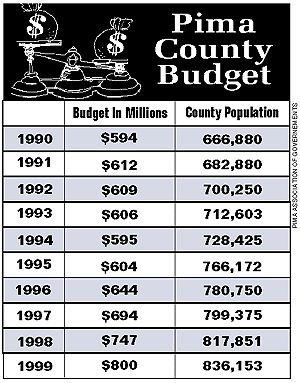 It is the treasurer who manages and distributes tax revenues.
It is the treasurer who manages and distributes tax revenues.
Kirk's office has had its own problems. As early as 1974, thousands
of dollars in interest owed to the Tucson Unified School District
was diverted into the county's general fund. Twenty years later,
Kirk's office botched the interest allocations to 60 accounts.
Repeated reports by the Auditor General said Kirk needed to address
problems in interest allocation. And finally, Kirk was hit by
scathing management audit reports that faulted him for archaic
practices that led to a combined $4 million loss for the county
and school, fire and special districts and for an "overt
personal relationship" with his chief deputy, Barbara Lynn
Chadwick. The audit came just as the campaign season kicked off
in early 1996. He won easily anyway.
ONCE AGAIN, KIRK has been thrust into a defensive posture.
This time, the defense is somewhat muted. Though the county's
borrowing from the pooled accounts has been the subject of a few
articles in the dailies, no reporter had contacted Kirk until
The Weekly interviewed him earlier this month.
The denial was ready. Kirk is being made to be a scapegoat, he
says in a statement that, oddly, was a request for a retraction
that he sought from no one in particular and never sent.
Kirk says Finance Director Carol Bonchalk "chose to show
in Pima County's fiscal year 1997-98 Comprehensive Annual Financial
Report that the negative balances of Kino Hospital, the Stadium
District (including Tucson Electric Park) and certain other county
entities were covered by 'investment trusts,' which led the Auditor
General to make the statement that 'deficit cash balances of County
activities are being covered by the restricted school district
cash balances.'
"In truth and in fact, the treasurer did not borrow or transfer
any monies from any school district to cover deficit balances
in some county funds," Kirk says.
Rather, he explains, Bonchalk and her staff paid Kino bills with
warrants that were covered by other county funds.
And he says Bonchalk and County Administrator Chuck Huckelberry
made the financial reporting choice to protect the county's bond
ratings, which suffered a slip in one case last year.
NOTHING IS SIMPLE in county government. In fact the semi-annual
payments property owners make each year may be the easiest thing
about it. There are some 70 basic taxing entities in Pima County,
including the county, state and five municipal governments, Pima
Community College, 16 school districts, 19 fire districts, 22
improvements districts, four water districts and a health district.
Some, like the county with five, have distinct tax categories
to push the number of separate levies to almost 90.
Still, the taxpayer makes only one check. It is paid to the treasurer's
office and deposited. The treasurer acts as a sort of central
bank or clearinghouse. Money is kept in two big pools. One is
the Local Government Investment Pool, managed not by Kirk but
by the state treasurer. Money from the pool can be accessed generally
overnight.
Amounts in the pools vary. But on June 9 there was $194 million
in the Local Government Investment Pool and another $300 million
in the other Treasurer's pool.
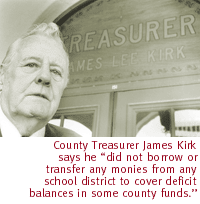 The other pool is managed by the county treasurer in other investments.
Kino's deficits were covered from this second pool.
The other pool is managed by the county treasurer in other investments.
Kino's deficits were covered from this second pool.
There are options when Kino (which lost $14 million in the last
12 months) or other accounts are in deficit. The county can make
payments for the negative account out of the combined other funds.
Or Kirk could use the county's line of credit with Bank of America,
which can easily be increased from its current $30 million limit.
Kirk also could utilize registered warrants, a sort of overdraft
protection that logs amounts for accounts with insufficient funds
that are later repaid with interest.
Faced with more deficits in March, Kirk--as he was asked by county
officials to do in 1996--used the bank line of credit. But borrowing
from the pooled funds also has recurred. A line of credit should
be adequate. State law allows the county to have a line of credit
of more than $100 million.
While the finances of each government and the pool fluctuate,
the June 30 report--the end of the fiscal year--is a snapshot
that freezes the otherwise constant action. It is then that Kino
showed its deficit and then that its bills for everything from
doctors and medicine to food were covered with pooled money.
Kirk says he knew enough that on June 30, there was $53 million
in county accounts, meaning Kino theoretically didn't touch any
school money.
Bonchalk doesn't argue that there was that amount of county cash.
But how much of it was available is the next dispute.
Even within the county, some funds are restricted. For instance,
the county could not use proceeds from bond sales that are awaiting
expenditure on one of the many projects voters approved two years
ago. The county also could not use federal or state grants or
the account filled with fees paid by developers and builders.
Use of that money in the 1980s prompted a lawsuit by builders
against the county. In the suit, settled just before going to
trial, developers complained their fees built a surplus that was
diverted to cover deficits at Kino and other county departments.
"The Treasurer can't really say whose money is whose,"
says Dennis Mattheisen, financial audit director for the state
Auditor General. "But if you look at the whole of that pool,
most of it is made up of school district money."
The school districts suffered no losses, Mattheisen and other
auditors say.
SUPERVISOR RAY CARROLL, a Republican from eastside and
Green Valley District 4, said during an April 6 Board of Supervisors
discussion of the borrowing that he would rather take money from
the development community than "from the kids."
No one from the school districts is howling.
An engineer by training, the old-school Kirk, sometimes in a
favorite suede lavender jacket, is at work these days by 5:30
a.m.
Kirk's political life, which includes seven years on the City
Council, has far outlasted those of friends and foes. He lived
through the three terms of Supervisor Ed Moore, a Democrat-Republican-Independent.
While Moore successfully targeted two other elected officials--Democratic
Recorder Dick Kennedy in 1988 and Democratic Assessor Alan Lang
in 1994--he didn't faze Kirk.
Moore is shooting again. With information from Moore, Carroll
is asking the county attorney if Kirk has violated provisions
in six laws governing the management of public monies.
Carroll's final question is vintage Moore. "Do you believe
that any of the aforementioned issues constitute a defalcation
or neglect of duty as stipulated in" the Arizona Revised
Statutes?
Kirk is far from riled.
"Politicians," he says of those lining up against him,
"oft times fail to see the light. Rather, they feel the heat."

|





